What
is ecological site classification?
In the growth simulator SIBYLA, site
quality classification is used instead of forest yield classes. Site quality is
evaluated directly from ecological site characteristics: climate, air, and soil.
The ecological characteristics are called site variables. They directly
influence the production capacity of a stand (tree height and diameter increment).
The growth simulator SIBYLA uses the model of ecological classification applied in
the growth
simulator SILVA 2.2, which was derived by Kahn
(1994).
What
site variables are used in the growth simulator SIBYLA ?
In the simulator,
the following site variables are used:
-
s1 (N2O) ... NOx
concentration in air (ppb)
-
s2 (CO2) ... CO2
concentration in air (ppm)
-
s3 (NUTR) ...
soil nutrient supply (relative value in
the range from 0 to 1)
-
s4 (DAYS) ...
number of days in the vegetation period (days with daily mean temperature above 10°C)
-
s5 (TAMPL) ...
annual temperature amplitude (the difference between annual minimum
and maximum temperature in °C)
-
s6 (TEMP) ... daily
mean temperature in the vegetation period in °C (from April to September)
-
s7 (MOIST) ...soil
moisture (relative value in the range from 0 to 1)
-
s8 (PRECIP) ...
precipitation amount in the vegetation period in mm (from April to September)
-
s9 (ARID)...
aridity index according to de Martone in mm.°C-1
derived as:
 |
How
do site variables affect tree increment?
|
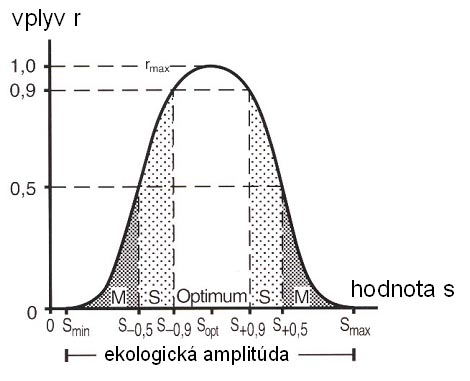
|
Transformation
functions
Transformation functions are used
to transform the effect of site variables si to
relative values. The functions are based on the theory of fuzzy sets.
The principle is shown in Figure 1. On the axis x, the
ecological amplitude of the characteristic s, i.e. its range from
minimum to maximum value, in which the particular tree species can survive,
is represented. The axis y depicts the transformed values of the
influence r in the range from 0 to 1. The transformation function
is simplified using the break points (cj), between
which the linearised transformation sections are formed
as follows:

Table 1 presents the values of
break points (cj) for individual tree species.
Note: The growth simulator
SIBYLA is parameterised only for spruce, fir, pine, beech, and oak. All
other tree species are simulated on the base of the tree species with the
closest production relationship !!! |
|
Table
1 Values of transformation function coefficients within the ecological
amplitude (according to Kahn 1994)
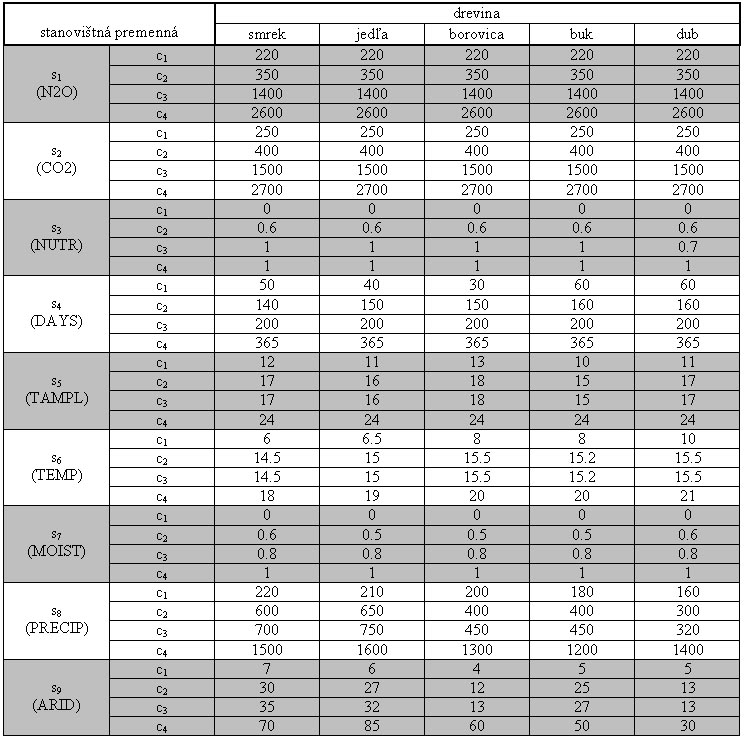
|
|
Agregation
functions
In the next step, total nutrition
effect (rN), total temperature effect (rT),
and total humidity effect (rH) are calculated
using the aggregation functions:

Afterwards,
the effects are aggregated to obtain three reduction factors: the reduction of
the asymptote of the tree height growth potential
(rA), the reduction of the culmination age of the height increment
potential (rtkulm), and the reduction of the tree basal area
increment potential (rg) as
follows:

Gama coefficients are
published in Fabrika (2005).
|
How
is tree increment simulated?
Both height and diameter increments are
simulated directly on the base of the ecological site classification, tree vitality,
and competition pressure. The change of the crown shape is then derived from the
tree height and diameter.
How
is tree height increment simulated?
|
1. First, the coefficients A, k,
p of Korf function applied for modelling the height
growth potential are determined from the ecological site classification
using the interpolation principle:
A = A0 + A1
. rA
tkulm = t0
+ t1 . rtkulm
p = a0 + a1
. tkulm + a2 . tkulm2
k = tkulm(p-1)
. p
2.
If the tree age is unknown, the theoretical age t is estimated from the growth
potential using the actual tree height h:

3. For the time period delta
t = 1 year a potential tree height increment ihpot
is calculated as follows:

4. On the base of
the tree crown lateral area cS,
the reduction factor of tree vitality rV is
calculated as:

5. Using the characteristics
obtained from the competition model, the reduction
factor of the competition pressure on tree rC is
determined as:

where delta CCL is the
change of the competition index CCL before and after the thinning
treatment. The other competition characteristics represent the
conditions after thinning.
6. Finally, tree height increment ih
is calculated as follows:

7. and the residual
element of the tree height increment, which includes the systematic error
resulting from the model calibration, is generated:
ih' = ih +
Gauss(biasih, sih)
All coefficients were published in Fabrika (2005). |
How
is tree diameter increment simulated?
|
1.Using Korf function, maximum
tree diameter increment idmax is calculated from
the actual tree diameter:
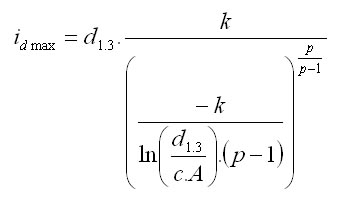
2. Maximum tree basal area
increment igmax is determined from the actual (initial)
tree
diameter and the calculated maximum diameter increment using the mathematical
relationship between the diameter and the basal area:

3. To obtain an expected tree basal
area increment ig, maximum basal area increment is
reduced by the site reduction factor rg, reduction factor of
tree vitality rV, and reduction factor of competition
pressure rC according to:

4. Finally, the annual tree
diameter increment is determined from the basal area increment using their
mathematical relationship:

5. At last, the residual
element of the tree diameter increment, which also includes the systematic
error resulting from the model calibration, is generated:
id' = id +
Gauss(biasid, sid)
All coefficients can be found in Fabrika (2005). |
How
is the change of tree crown simulated?
|
Crown parameters, i.e. height
to crown base (ch) and crown
diameter (cd), are derived indirectly using the so called cross
relationships of the tree height and diameter increments. The increments
of height to crown base (ich) and of crown diameter (icd)
are then calculated as:
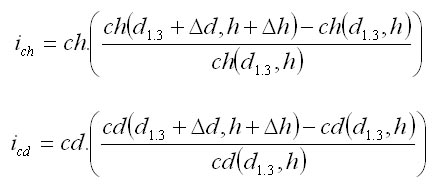 |
How
are site variables generated?
In the cases, when site variables are unknown,
they can be derived (generated) from the readily available information:
-
forest ecoregion
-
altitude
-
aspect
-
slope
-
year
-
forest type
How
are climatic characteristics generated?
|
Generation of climatic
characteristics is based on climate regionalisation (Ďurský,
Minďáš, Konôpka 2002), from which the table of climatic
amplitudes was created (Borgoň 2003).
Climate
regionalisation
The regionalisation of climate is based
on the measurements from
meteorological stations. For individual meteorological stations,
necessary site variables (s4,s5,s6,s8)
were calculated following the methodology of the World Meteorological
Organisation (WMO). Regression equations describing the relationships
between site variables and elevation of the weather station were derived:

For each meteorological station the
real error of the regression model was calculated as follows:

The errors were regionalised in GIS
environment using spatial interpolation techniques. A raster layer of site
variables was created on the base of the digital terrain model and the regression
model. To this raster layer, the raster layer of the interpolated errors was
added according to the rules of the map algebra:

which resulted in corrected rasters
of climatic site variables. The whole process is shown in Figure 2. |
|
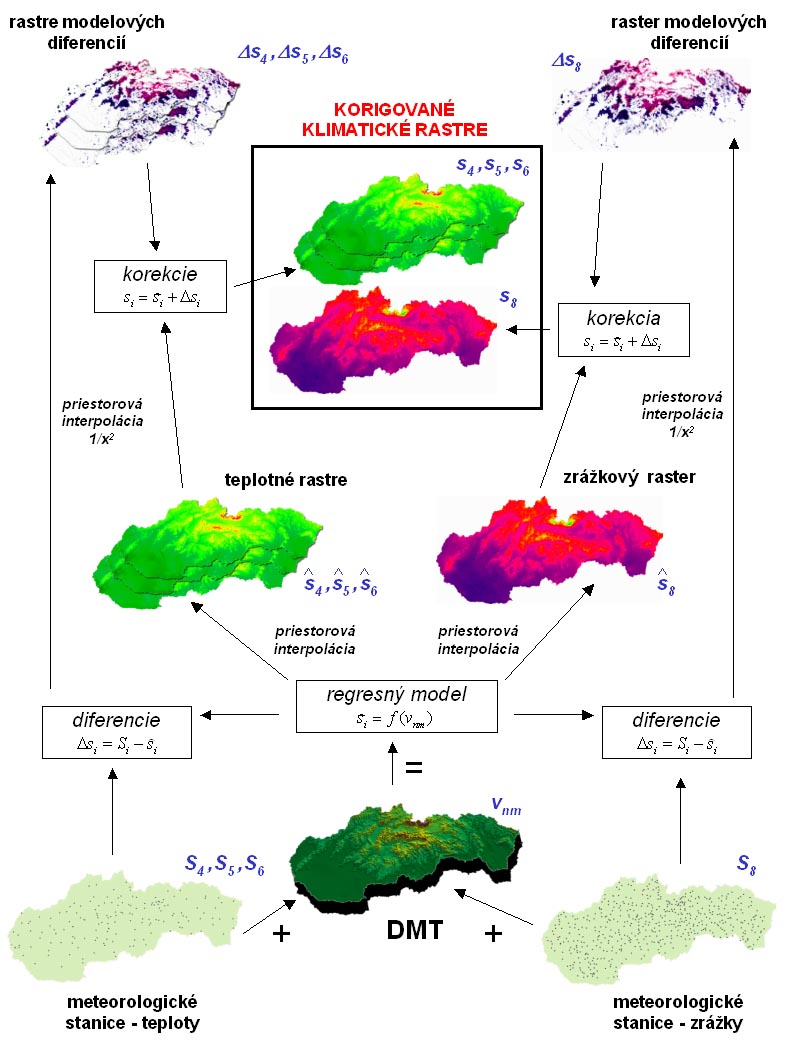
Figure 2 Regionalisation of
climatic characteristics in GIS environment
|
|
Table
of climatic amplitude(s)
For individual forest
ecoregions of Slovakia, minimum (vnm min)
and maximum
(vnm max) elevations were derived, for which necessary site
variables ( , , )
were derived from climatic rasters. The results are saved in the database table.
This table serves for the interpolation of site variables of the particular forest stand
with regard to the forest ecoregion the stand belongs to, and its elevation
(vnm): )
were derived from climatic rasters. The results are saved in the database table.
This table serves for the interpolation of site variables of the particular forest stand
with regard to the forest ecoregion the stand belongs to, and its elevation
(vnm):

Finally, the interpolated site
variable is adjusted by aspect and slope of the forest stand
using the modifiers derived by Kahn
(1994):

where

|
How
are air characteristics generated?
|
Site variables s1 and s2,
i.e. the concentration of NOx
and CO2 in air in ppb and ppm, respectively, are calculated
from the regressions taken over from the model SILVA 2.2 (Kahn 1994).
Their values depend on the calendar year (t):
s1 = 287,6 + 0,00048
. (t - 1800)2
s2 = 280,37 + 0,00177
. (t - 1800)2
|
How
are soil characteristics generated?
|
Soil site variables s3 and s7,
i.e. soil nutrient supply and soil moisture, are transformed from the
original relative values within the interval <0;1> to qualitative
degrees with a predefined range of relative values and their mean as
presented in Tables 2 and 3. For soil nutrient supply 5 degrees, and for
soil moisture 9 degrees were distinguished. The degrees are adopted from Chen
and Hwang (1992). The particular forest stand (simulation plot)
is assigned the qualitative degree depending on the forest type the
stand belongs to. Ujházy
(2001) created the conversion table of forest types
to degrees of soil moisture and soil nutrient supply.
|
|
Table 2 Values assigned to
the degrees of soil nutrient supply

Table 3 Values assigned to the
degrees of soil moisture

|
© Copyright doc. Ing. Marek
Fabrika, PhD.
© Translated by Dr. Ing.
Katarína Merganičová - FORIM




















